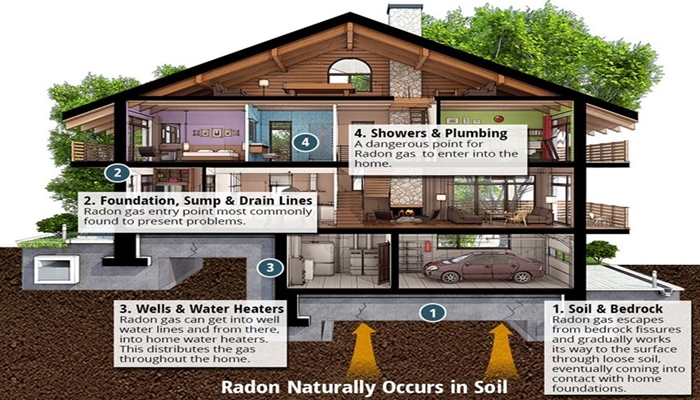Massachusetts Home Inspections YOUR INVESTMENT IS MY CONCERN

Radon Testing

Radon levels can vary significantly between neighboring homes in Massachusetts, so test results from a neighbor may not accurately reflect the radon risk in your own home. Additionally, factors like precipitation, barometric pressure, and seasonal changes can cause radon levels to fluctuate on a daily or monthly basis. This is why both short-term and long-term testing options are available.
Testing is the only reliable way to determine if a home has elevated radon levels. Radon concentrations can fluctuate daily, with the highest levels typically occurring during the heating season. Factors such as weather conditions, the use of furnaces and fireplaces, and the opening or closing of windows and doors all contribute to these variations.
TESTING PROCEDURE
The EPA recommends performing an initial radon test using a short-term measurement device placed on the lowest livable level of your home. I carry a supply of these recommended charcoal-based short-term radon test kits in my vehicle. A standard double-canister testing kit is available for $95.00, offering a quick and efficient way to measure radon levels in any home.
These kits should remain in the home for a minimum of 48 hours and a maximum of 72 hours. If you decide to test for radon, I will personally guide you through the process of properly sealing the radon canisters after they’ve been placed in the basement for the required duration.
When it's time to retrieve the radon kit, simply record the stop date and time on the blue document provided. Next, place the covers on each canister, re-seal them with the tape provided, and place both canisters, along with the paperwork, into the prepaid Priority Mail envelope (which I’ll supply with the test kit). Finally, drop the envelope off at your local post office.
Your radon test results will be emailed to you within two days of mailing the test kit. Another option is to obtain your results online at NEW ENGLAND RADON website. Your canister numbers can be found on Page 1 of your report next to Radon Air Quality.

Short-term radon testing under closed-building conditions allows residents to quickly determine if their home has dangerously high radon levels. During the test, all windows and exterior doors in the designated area should remain closed.
If radon test kits are placed in your prospective home, your Realtor should advise the sellers to keep windows and doors closed as much as possible during the test. It’s also helpful if your Realtor informs the seller’s Realtor and requests that windows and exterior doors remain closed for at least 12 hours prior to the test.
For the most accurate results, I recommend avoiding radon testing during severe storms or periods of unusually high winds, as these conditions can impact radon levels.
LOWERING RADON LEVELS IN YOUR HOME
There are several ways to reduce radon levels in a home. In some cases, sealing cracks in basement floors and walls can help limit radon entry. In others, more effective solutions may involve installing mitigation systems that use pipes and fans to actively lower radon levels.
One common method is sub-slab depressurization, which works by drawing radon gas from beneath the concrete slab and venting it outside before it can enter the home. This technique typically doesn't require major structural changes. Similar mitigation systems can also be adapted for homes with crawl spaces.
Based on the specific design and structure of the home, radon mitigation professionals may recommend supplementary or alternative techniques to achieve effective and sustained radon reduction.
SEE A TYPICAL RADON MITIGATION SYSTEM
IF YOU PRESENTLY HAVE A MITIGATION SYSTEM INSTALLED
I highly recommend testing your home's radon levels annually to ensure that your mitigation system is operating effectively. I am available to deliver test kits to your residence at any time throughout the year—simply reach out, and I will be happy to schedule a visit to place short-term test canisters in your home.
In the meantime, it is advisable to regularly monitor the pressure gauge on the radon piping in your basement. The U-shaped manometer should display two distinct liquid levels—one higher and one lower. Equal liquid levels indicate that the system’s fan is not functioning. If this occurs, I recommend contacting the installation company without delay. A contact number is typically posted near the gauge for your convenience.
TEST BEFORE YOU RENOVATE
If you are planning major structural renovations in your new home—such as converting an unfinished basement into a living area—it is essential to test the space for radon prior to beginning the project. If elevated radon levels are detected, radon-resistant construction techniques can often be incorporated into the renovation at a relatively low cost.
Because significant renovations can impact radon levels, it is equally important to conduct a follow-up test after the work is completed to ensure continued safety.
MASSACHUSETTS RADON MAP

Zone 1 areas have the highest potential for radon exposure, with average indoor screening levels above 4 pCi/L.
Zone 2 areas have moderate potential, with average screening levels ranging between 2 and 4 pCi/L.
Zone 3 areas have the lowest potential, with average indoor radon levels below 2 pCi/L.
For additional information about radon, please visit the U.S. EPA website at: https://www.epa.gov/radon
Here is what my clients have to say about my home inspection services:
Press F5 (on your keyboard) for additional testimonials
Dave had an impressive website that seemed to be too thorough to be anything but genuine. The thing that seemed to sell me was that he says right on his website that you may pay a little more for his service, but that his quality is higher. So I decided to give him a try even though I had no reference from another person hoping for someone of top quality. I was not disappointed. He was at the home early as promised and had done an inspection of the exterior and was writing up notes so that when I arrived, he walked me through the exterior first. Even with his early arrival, we were still there for about 3 hours looking through every little corner and cubby. He would occasionally stop and fill out his inspection forms which were easy to follow and read; he gives you a full folder of his notes that are well organized.
Dave was open to all questions and concerns so every time I saw something that was potentially concerning to me, he would look, give his opinion and often shared other experiences with similar circumstances. He also had a good sense of humor which helped to lighten what can be a stressful experience (having someone pointing out problem items that you didn't see). I would highly recommend Massachusetts Home Inspections.
Michael














